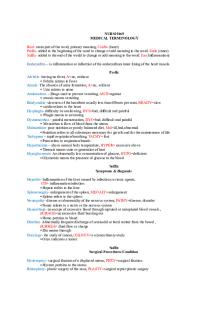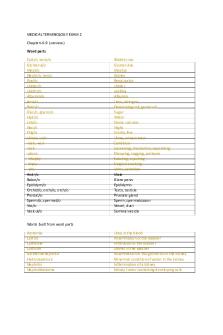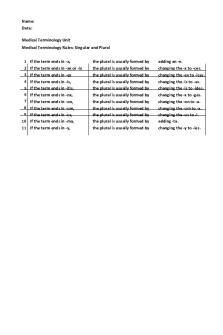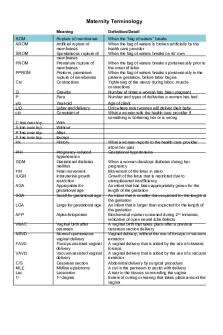Medical Terminology - An Introduction PDF

| Title | Medical Terminology - An Introduction |
|---|---|
| Course | Public Health |
| Institution | Cagayan State University |
| Pages | 16 |
| File Size | 459.7 KB |
| File Type | |
| Total Downloads | 83 |
| Total Views | 144 |
Summary
Medical Terms...
Description
Unit 1: MEDICAL TERMINOLOGIES – AN INTRODUCTION Introduction With the great advancements in medicine throughout the 20th century, medical language changed with the times and continues to do so today. Some words are discarded or considered obsolete, whereas others are changed, and new words are continually added. Approximately 75% of all medical terms are based on Latin or Greek terms, even though modern-day changes are made to make the terms more comprehensive. Etymology indicates the origin and historical development of a term. With the advent of the medical dictionary, terminology came to the masses with full force. Today, medical terminology has evolved into modern applications from basic anatomy to include alternative, holistic, naturopathic, and complementary medicine.
Learning Outcomes: At the end of this unit, you are expected to: 1. identify the meaning of the root words, prefixes, and suffixes commonly used in medical terminologies; 2. use commonly used prefixes and suffixes correctly; and 3. define the meanings of common medical terms used in the practice of respiratory therapy.
Presentation of Contents To start learning medical terminology, you have to break down the parts of each word and then deciphering its meaning. Etymology is the study of the history of words, their origins, and how their form and meaning have changed over time. You can use etymology to decipher words with Latin and Greek origins, eponyms, (words name after people), and acronyms (modern language terms that stand for longer phrases).
DID YOU KNOW? While the prefix gives you a clue into what to expect in a word’s meaning, the suffix tells you what is happening with a specific body part or system. And, usually, it entails what is wrong with you or the procedure use to diagnose or fix it.
INTRODUCING THE BIG THREE: Prefixes, Roots and Suffixes Almost every medical term can be broken down into some combination of prefixes, roots, and suffixes. Because they are the core of a word’s meaning, the root words are great in number. There are many more roots than prefixes and suffixes put together.
DID YOU KNOW? To define an unfamiliar term, you will simply: 1. identify its word elements; 2. analyze the meaning of each word element; and 3. put the meanings of all the word elements together to define the word as a whole
MEDICAL TERM TERMINOLOGY INOLOGY
1
ROOT WORDS The central meaning of a term is conveyed by a word element called the root word. It is the foundation to which other word elements are added to a build a complete, meaningful word. All terms have at least one root word. When being connected to other word elements, root words are converted into combining forms. A combining form is a root word to which a combining vowel has been added to link the root word to a second root word or to a suffix. In medical terminology, root words (and their associated combining forms) usually refer to anatomic structures or physiologic concepts. Memorizing just a few will enable you to understand a wide variety of medical terms. Examples: Root word Cardi/o Immune/o Respire/o
Root Word adeno arterio arthro cardio cephalo cholecyst colo cranio cyto derma endo entero gastro hepato myo nephro osteo peri phlebo pneumo pulmono pyo pyro reno spleno sub thoraco thrombo vaso
Combining form cardio immuno respiro
Meaning heart immunity breathing
ROOT WORDS Meaning gland Pertains to the artery Pertains to the joint Pertains to the heart Pertains to the head Pertains to the gallbladder Pertains to the large intestine Pertains to the cranium Pertains to the cell Pertains to the skin Within Pertains to the intestine Pertains to the stomach Pertains to the liver Pertains to the muscle Pertains to the kidneys Pertains to the bone around Pertains to the veins Pertains to the lungs Pertains to the lungs Pus Fever Pertains to the kidneys Pertains to the spleen Under Pertains to the chest or thorax Clot Pertains to the blood vessels
MEDICAL TERM TERMINOLOGY INOLOGY
2
EXTERIOR ROOT WORDS The table below lists he root words and combining forms that pertain to the exterior of the body. Exterior Root Acr/o Amb/i Anter/o Aut/o Axill/o Blephar/o Brachi/o Bucc/o Canth/o Capit/o Carp/o Caud/o Cephal/o Cervic/o Cheil/o, chil/o Cheir/o, chir/o Cili/o
Combining Form Acro Ambi Antero Auto Axillo Blepharo Brachio Bucco Cantho Capito Carpo Caudo Cephalo Cervico Cheilo, chilo Cheiro, chiro Cilio
Cor/e, cor/o Crani/o Cubit/o Dactyl/o Derm/a, derm/o, dermat/o Dors/i, dors/o Faci/o Gingiv/o Gloss/o Gnath/o Inguin/o Irid/o Labi/o Lapar/o Later/o Lingu/o Mamm/a, mamm/o Mast/o Nas/o Occipit/o Ocul/o Odont/o Omphal/o Onych/o Opthalm/o, ocul/o Optic/o, opt/o Or/o Ot/o Papill/o Pelv/o, pelv/i
Coree, coro Cranio Cubito Dactyl Derma, dermo, dermat
What it Means Extremities Both sides/double Front Self Armpit, axilla Eyelid or eyelash Arm Cheek (on the face) Angle formed where eyelids meet Head Wrist Tail/downward Head Neck or cervix (neck of uterus) Lip Hand Eyelash or eyelid, or small hairlike processes Pupil of eye Skull Elbow Fingers or toes Skin
Dorsi, dorso Facio Gingivo Glosso Gnatho Inguino Irido Labio Laparo Latero Linguo Mamma, mammo Masto Naso Occipito Oculo Odonto Omphalo Onchyo Opthalmo, oculo Optico, opto Oro Oto Papillo Pelvo, pelvi
Back or posterior Face Gums in mouth Tongue Jaws Groin Iris of eye Lips Abdomen, loin, or flank Side Tongue Breast Breast Nose Back of the head Eye Teeth Umbilicus Nails Eyes Seeing, sight Mouth Ear Nipple Pelvis MEDICAL TERM TERMINOLOGY INOLOGY
3
Phall/o Pil/o Pod/o Rhin/o Somat/o Steth/o Stomat/o Tal/o Tars/o Thorac/o Trachel/o Trich/o Ventr/i, ventr/o
Phallo Pilo Podo Rhino Somato Stetho Stomato Talo Tarso Thoraco Trachelo Tricho Ventri, ventro
Penis Hair Foot Nose Body Chest Mouth Ankle Foot Chest/ thorax Neck or neckline Hair or hairlike Front of body
COPYCATS AND OPPOSITES Some prefixes might look very different but have the same meaning. Examples: • Anti- and contra- mean against • Dys- and mal- mean bad or painful • Hyper-, supra-, and epi- all mean above • Hypo-, sub-, and infra-all mean below • Intra- and endo mean within However, other, more troublesome prefixes mean the opposite of each other even though they look or sound similar. These are contentious prefixes: • • • • •
Ab- means away from (abduct), but ad- means toward Ante- pre-, and pro- means before, but post- means after Hyper-, supra-, and epi- means above, but hypo-, infra-, and sub- means below Tachy- means rapid, but brady- means slow Hyper- also means excessive, yet hypo also means deficient
INTERIOR ROOT WORDS The table below list the root words and combining forms associated with the body’s interior parts. Interior Root Abdomin/o Acanth/o Acetabul/o Acromi/o Aden/o Adip/o Adren/o Alveoli/o Angi/o An/o Aort/o Arteri/o, artero Arteiol/o Aspir/o
Combining Form Abdomino Acantho Acetabulo Acromio Adeno Adipo Adreno Alveoli Angio Ano Aorto Arterio, artero Arteriolo Aspiro
What it Means Abdomen Spiny or thorny Acetabulum Acromium Gland Fat Adrenal gland Air sac Vessel Anus Aorta Artery Arteriole To breathe in MEDICAL TERM TERMINOLOGY INOLOGY
4
Ather/o Athr/o, articul/o Atri/o Audi/o, aur/i Balan/o BioBronch/i, bronch/o Bronchiol/o, bronchiol/i Cancin/o Cardi/o Cellul/o Cerebell/o Cerebr/i, cerebr/o Cholangi/o Chol/e Cholecyst/o Choledoch/o Chondr/i, chondro Chrom/o, chromat/o Col/o, colon/o Colp/o Cost/o Cry/o Crypt/o Cutane/o Cyan/o Cysti, cyst/o Cyt/o Dipl/o Duoden/o Encephal/o Enter/o Episi/o Erythr/o Esophag/o Fibr/o Galact/o Gastr/o Glyc/o Gynec/o Hemat/o, hem/o Hepat/o, hepatic/o Heter/o Hidr/o Hist/o, histi/o Hom/o, home,o Hydr/o Hyster/o Latr/o Ile/o Ili/o Intestin/o Jejun/o Kerat/o
Athero Arthro, articulo Atrio Audi, auri Balano Bio Bronchi, broncho Bronchiolo, bronchioli Carcino Cardio Cellulo Cerebello Cerebri, cerebro Cholangio Chole Cholecysto choledocho Chondri, chondro Chromo, chromato Colo, colono Colpo Costo Cryo Crypto Cutaneo Cyano Cysti, cysto Cyto Diplo Duodeno Encephalo Entero Episio Erythro Esophago Fibro Galacto Gastro Glyco Gyneco Hemato, hemo Hepato, hepatico Hetero Hidro Histo, histio Homo, homeo Hydro Hysteron Latro Ileo Ilio Intestio Jejuno Kerato
Plaque, fat Joint Atrium Hearing Glans penis Life Bronchus Bronchiole Cancer Heart Cell Cerebellum Cerebrum Bile duct Bile Gallbladder Common bile duct Cartilage Color Colon Vaganina Rib Cold Hidden Skin Blue Bladder or cyst Cell Double, twice Duodenum Brain Intestine Vulva Red Esophagus Fibers Milk Stomach Sugar Female Blod Live Other, different Sweat Tissue Same, alike Water, wet Uterus Treatment Ileum (intestine) Ilium (pelvic bone) Intestine Jejunum Cornea of eye, horny tissue MEDICAL TERM TERMINOLOGY INOLOGY
5
Lacrima Layng/o Leuk/o Lipid/o Lith/o Lymph/o Melan/o Men/o Mening/o Metr/a, metr/o My/o Myel/o Myring/o Nat/o Necr/o Nephr/o Neur/o Oophor/o Orchid/o, orchi/o Oss/eo, oss/i, ost/e, ost/eo Palat/o Path/o Peritone/o Pharmac/o Pharyng/o Pleb/o Phren/o Pleur/o Pneum/a, pneum/o Pneum/ato, pneum/ono Poli/o Proct/o Pulmon/o Py/o Pyel/o Rect/o Ren/i, ren/o Sacr/o Salping/o Sarc/o Scapul/o Sept/o Splen/o Spondyl/o Stern/o Tend/o, ten/o, tendin/o Testicul/o Therm/o Thorac/o Thym/o Thyr/o Thyroid/o Tonsillo Trache/o
Lacrima Laryngo Leuko Lipido Litho Lympho Melano Meno Meningo Metra, metro Myo Myelo Myringo Nato Necro Nephro Neuro Oophoro Orchido, orchio Osseo,, ossi, oste, osteo Palato Patho Peritoneo Pharmaco Pharyngo Plebo Phreno Pleuro Pneuma, pneumo Pneumato, pneumono Pilo Procto Pulmono Pyo Pyelo Recto Reni, reno Sacro Salpingo sarco Scapulo Septo Spleno Spondylo Sterno Tendo, teno, tendin Tesiculo Thermo Thoraco Thymo Thyro Thyroid Tonsillo Tracheo
Tears Larynx White Fat Stone (in gallbladder or kidney) Lymph vessels Black Menses, menstruation Meninges Uterus Muscle Bone marrow or spinal cord Eardrum Birth Death Kidney Nerve Ovary Testis Bone Root of mouth Disease Peritoneum Drug Pharynx Vein Diaphragm Pleura, rib (side) Lungs Lungs Gray matter of nervous system Rectum, anus Lungs Pus Pelvis of kidney Rectum Kidney Sacrum Fallopian tube Flesh Scapula Infection Spleen Vertebra Sternum Tendon Testis Heat Chest Thymus Thyroid gland Thyroid gland Tonsils Trachea MEDICAL TERM TERMINOLOGY INOLOGY
6
Tympan/o Ur/e, ur/ea, ur/eo, urin/o, ur/o Ureter/o Urethr/a Uter/o Vas/o Vas/o, ven/o, ven/i Vesic/o Viscer/o Xanth/o Xer/o
Tympano Ure, urea, ureo, urino, uro
Eardrum Urine
Uretero Urethra Utero Vaso Vaso, veno, veni Vesico Viscera Xantho Xero
Ureter Urethra Uterus Vas deferens Vein Bladder Viscera (internal organs) Red, redness dry
SEMANTICS The word semantics is derived from the Greek semantikos, meaning “significant.” It is only appropriate, then, that you take a moment to digest what exactly is meant by the word semantics. Semantics is, quite simply, the study of meaning in communication. A morpheme is the smallest linguistic unit that has semantic meaning. For example, un means not, or opposite.
PREFIXES Virtually all medical terms contain root words and suffixes. Many contain prefixes as well. A prefix is a word element added in front of the root(s) to modify the basic meaning of the word. For example, consider the term bradycardia. brady = slow cardi = heart a = condition prefix root word suffix Bradycardia literally means slow heart condition; it is used to describe a condition characterized by a slow heartbeat. Substituting one prefix for another can dramatically change the meaning of a term. For example, let’s replace the prefix brady with the prefix tachy. The term tachycardia is broken down as follows: tachy = fast prefix
cardi = heart root word
a = condition suffix
Prefixes and suffixes are modifiers or adjectives that alter the meaning of the root word, in the same ways as regular English terms.
A-, anante anti bi de di
PREFIXES Lack of, without, not Before, in front of, or forward Opposing or against Double, two, twice, both Down, or from Twice or two MEDICAL TERM TERMINOLOGY INOLOGY
7
anaero brady cryo homo hydro hyper hypo inter intra intro iso micro macro mono neo pseudo post pre tachy trans ultra
Without oxygen Slow Cold Same, like Water Above normal, excessive, increased Below normal, under, decreased Between Within, inside Into, or within Same Small Large One New False After Before Rapid Through or across Excessive, beyond
SUFFIXES A suffix is a word element added after a root word to modify the basic meaning of the word. It is always at the end of a word, usually indicates a procedure, a condition, or a disease. To illustrate, let’s look at a familiar medical term, cardiology. This term can be broken down into two elements: cardi/o = heart root word
logy = study of suffix
The first word element is a combining form, cardi/o, which means heart. Note that cardi/o consists of a root word (cardi) to which a combining vowel (o) has been added in order to link it to a suffix that modifies its basic meaning. The suffix is logy, which means study of. Thus, cardiology is the study of the heart. Let’s look at another example, cardiac. This term can be also be broken down into two word elements: Cardi/o = heart Root word
ac = pertaining to suffix
The root word cardi means heart. The suffix ac means pertaining to. Cardiac is an adjective meaning pertaining to the heart. Note that root word cardi is used rather than the combining form cardi/o. Cardi is connected directly to the suffix without a combining vowel because the suffix ac begins with vowel rather than a consonant. In general, the combining vowel is added only when linking a root word to a suffix that begins with a consonant. When linking a root word to a suffix that begins with a vowel, the combining vowel is dropped. Thus, the correct term is cardiac, not cardioac. MEDICAL TERM TERMINOLOGY INOLOGY
8
Suffixes algia cele ectomy emia genesis graphy itis lysis megaly ology ologist oma orraphy oscopy osis ostomy otomy pathy penia pexy plasty pnea pnia poiesis scope scopy
SUFFIXES Meaning Pain Hernia of Surgical removal, excision of Blood Pertains to production of or generation of That which describes or writes Inflammation of Reduction or loosening of Enlargement Study of One who studies, specialist Tumor Surgical repair or sewing of Inspection of, looking into Pertains to a disease or morbid process Creation of an opening Incision into Disease, disease process deficiency Fixation of Repair of Pertains to respiration Pertains to carbon dioxide Formation Instrument used to visually examine Process of visual examination
How to Decipher New Medical Terms Once you learn the common word elements, you can easily figure out that the electrocardiography is a procedure in which the electrical activity of the heart is recorded, while pericardiocentesis is a procedure in which the tissue (membrane) surrounding the heart is punctures with a needle. At this point, you will be well on your way to mastering medical terminology.
❖ ACRONYMS, EPONYMS, HOMONYMS, MULTIPLES AND PLURALS Acronyms An acronym is a word (or abbreviation) formed by the first letters or syllables of other words. Most acronyms are expressed in uppercase letters, but not always. For example, you might be familiar with the words scuba and laser. These terms are so well known that they have become acceptable as words. Scuba began life as an acronym for self-contained underwater breathing apparatus. Laser was an acronym for light amplification by stimulated emission of radiation.
Eponyms An eponym is a person, place, or thing from which a person, place, or thing gets (or is reputed to get) its name.
MEDICAL TERM TERMINOLOGY INOLOGY
9
In the medical field, a disease, sign, operation, surgical instrument, syndrome, or test is often named after a certain physician, surgeon, scientist or researcher. In current usage, it is now acceptable to drop the possessive apostrophe from most eponyms, so either is acceptable. For example, you can use Alzheimer’s or Alzheimer. •
APGAR Score: named after Virginia Apgar, American Anesthesiologist (1909-1974).
•
Alzheimer’s Disease: named for Alois Alzheimer, a German neurologist (1864-1915).
•
Cushing’s Syndrome: named for Harvey Williams Cushing, American surgeon (18691939).
•
Down Syndrome: named after John Haydon Down, English physician (1828-1896).
•
Gleason grade: named for Donald Gleason, American pathologist (1920-2008).
•
Hodgkin’s Disease: named for Thomas Hodgkin, an English physician (1798-1866).
•
Homan’s Sign: named for John Homans, American surgeon (1877-1954).
•
Ligament of Treitz: Named after Wenzel Treitz, a Czech physician (1819-1972).
•
Lyme Disease: named after a place, Old Lyme, Connecticut, where the disease was first reported in 1975.
•
Peyronie’s Disease: named for Francois de la Peyronie, a French surgeon (1678-1747).
•
Parkinson’s Disease: named for James Parkinson, English physician (1755-1824).
Homonyms A homonym is a word that has the same pronunciation as another, but a different meaning, and in most cases a different spelling (from the Greek homonymos: homos [same] + onyma [name]. ❖ MEDICAL RULES FOR FORMING PLURALS Some rules for pluralizing medical terms are as follows, with examples of the rule and exceptions to the rule. Medical Rule 1: Change the a ending to ae In other words, vertebra becomes vertebrae. By adding the e to the plural, the “aah” sound ending pronunciation becomes “eh.” • Axilla, axillae • Bursa, bursae • Conjunctiva, conjunctivae • Scapula, scapulae • Sclera, sclera Medical Rule 2: Change the um ending to a The a at the end is pronounced “aah.” • Acetabulum, acetabula • Antrum, antra • Atrium, atria MEDICAL TERM TERMINOLOGY INOLOGY
10
• • • •
Bacterium, bacteria Diverticulum, diverticula Labium, labia Medium, media
Media Rule 3: Change the us ending to i The I at the end is pronounced “eye.” • Alveolus, alveoli • Bronchus, bronchi • Coccus, cocci • Embolus, emboli • Fungus, fungi • Glomerulus, glomeruli • Meniscus, menisci • Syllabus, syllabi (but syllabuses is also acceptable) The exceptions to this rule include the following: • Corpus, corpora • Meatus, meatus (stays the same) • Plexus, plexuses • Viscus, viscera Medical Rule 4: Change the is ending to es The es is pronounced “eez.” • Analysis, analyses • Diagnosis, diagnoses • Exostosis, exostoses • Metastasis, metastases • Prognosis, prognoses • Testis, testes The exceptions to this rule are • Epididymis, epididymides • Femur, femora • Iris, irides Medical Rule 5: Change the ma or oma ending to mata Carcinoma, carcinomata • Condyloma, condylomata • Fibroma, fibromata • Leiomyoma, leiomyomata In Rule 5 examples, the English plural is also acceptable: condylomas, carcinomas, leiomyomas and fibromas.
Medical Rule 6: When a term ends in yx, ax, or ix, change the x to c and add es • Appendix, appendices • Calyx, calyces • Calix, calices (Strange but true, both are correct) • Thorax, thoraces
MEDICAL TERM TERMINOLOGY INOLOGY
11
Medical Rule 7: When a term ends in nx, change the x to g and add es • Larynx, larynges • Phalanx, phalanges Medical Rule 8: For Latin medical terms that consist of a noun and adjective, pluralize both terms • Condyloma acuminatum, condylomata acuminate • Placenta previa, placentae previae • Verruca vulgaris, verrucae vulgares There are (of course!) some excep...
Similar Free PDFs

Medical Terminology
- 50 Pages

Medical Terminology
- 6 Pages

Medical Terminology
- 2 Pages

Medical Terminology
- 4 Pages

Medical Terminology EXAM 2
- 4 Pages

Medical terminology Modules
- 158 Pages

Medical Terminology Terms
- 22 Pages

Medical Terminology-Plurals Quiz
- 3 Pages

Medical terminology 17
- 4 Pages

Med term - medical terminology
- 20 Pages

Medical Terminology Final Exam
- 5 Pages

Medical terminology 2
- 3 Pages
Popular Institutions
- Tinajero National High School - Annex
- Politeknik Caltex Riau
- Yokohama City University
- SGT University
- University of Al-Qadisiyah
- Divine Word College of Vigan
- Techniek College Rotterdam
- Universidade de Santiago
- Universiti Teknologi MARA Cawangan Johor Kampus Pasir Gudang
- Poltekkes Kemenkes Yogyakarta
- Baguio City National High School
- Colegio san marcos
- preparatoria uno
- Centro de Bachillerato Tecnológico Industrial y de Servicios No. 107
- Dalian Maritime University
- Quang Trung Secondary School
- Colegio Tecnológico en Informática
- Corporación Regional de Educación Superior
- Grupo CEDVA
- Dar Al Uloom University
- Centro de Estudios Preuniversitarios de la Universidad Nacional de Ingeniería
- 上智大学
- Aakash International School, Nuna Majara
- San Felipe Neri Catholic School
- Kang Chiao International School - New Taipei City
- Misamis Occidental National High School
- Institución Educativa Escuela Normal Juan Ladrilleros
- Kolehiyo ng Pantukan
- Batanes State College
- Instituto Continental
- Sekolah Menengah Kejuruan Kesehatan Kaltara (Tarakan)
- Colegio de La Inmaculada Concepcion - Cebu



